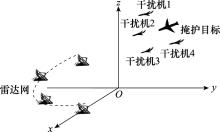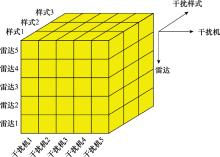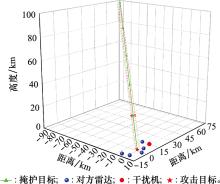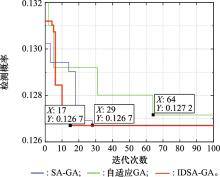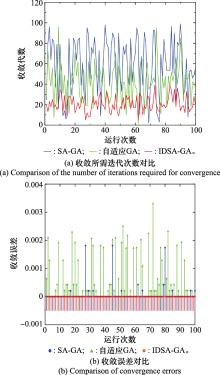Systems Engineering and Electronics ›› 2024, Vol. 46 ›› Issue (3): 824-830.doi: 10.12305/j.issn.1001-506X.2024.03.07
• Sensors and Signal Processing • Previous Articles Next Articles
Cooperative jamming resource allocation model for radar network based on improved discrete simulated annealing genetic algorithm
Zekun YAO1,2,*, Chao WANG1,2, Qingzhan SHI1,2, Shaoqing ZHANG3, Naichang YUAN1,2
- 1. College of Electronic Science and Technology, National University of Defense Technology, Changsha 410073, China
2. State Key Laboratory of Complex Electromagnetic Environment Effects on Electronics and Information System, National University of Defense Technology, Changsha 410073, China
3. Shenyang Aircraft Design & Research Institute, Aviation Industry Corporation of China, Shenyang 110035, China
-
Received:2022-02-28Online:2024-02-29Published:2024-03-08 -
Contact:Zekun YAO
CLC Number:
Cite this article
Zekun YAO, Chao WANG, Qingzhan SHI, Shaoqing ZHANG, Naichang YUAN. Cooperative jamming resource allocation model for radar network based on improved discrete simulated annealing genetic algorithm[J]. Systems Engineering and Electronics, 2024, 46(3): 824-830.
share this article
Table 1
Pulse compression gain of interference signal"
| 干扰样式 | 脉冲压缩增益 | 参数说明 |
| 随机移频干扰 | ζ为移频宽度 B为信号带宽 τ为信号时宽 | |
| 卷积灵巧 噪声干扰 | τn为噪声时宽 | |
| 间歇采样重 复转发干扰 | η为间歇采样占 空比, 取值0.5 |
Table 2
Detection probability of different CFAR detectors under interference"
| 恒虚警体制 | 多干扰目标下检测概率Pd |
| CA-CFAR | |
| GO-CFAR | |
| SO-CFAR | |
| OS-CFAR |
| 1 | 张养瑞. 对雷达网的多机伴随式协同干扰技术研究[D]. 北京: 北京理工大学, 2015. |
| ZHANG Y R. Research on key technologiesof cooperative ECM in multi-syndrome jammers for countering radar net[D]. Beijing: Beijing Institute of Technology, 2015. | |
| 2 | 赵忠凯, 王鸿. 组网雷达协同干扰资源分配模型及算法[J]. 火力与指挥控制, 2019, 44 (5): 85- 89. |
| ZHAO Z K , WANG H . Model and algorithm of cooperative jamming resource allocation for network radar[J]. Fire Control and Command Control, 2019, 44 (5): 85- 89. | |
| 3 | 陆青, 陈荣. 实用干扰资源智能管理和控制技术[J]. 舰船科学技术, 1998, (5): 47-50, 65. |
| LU Q , CHEN R . Practical interference resource intelligent management and control technology[J]. Ship Science and Technology, 1998, (5): 47-50, 65. | |
| 4 | 吕永胜, 王树宗, 王向伟, 等. 基于贴近度的雷达干扰资源分配策略研究[J]. 系统工程与电子技术, 2005, 27 (11): 1893-1894, 1974. |
| LYU Y S , WANG S Z , WANG X W , et al. Study on the allocation tactics for radar jamming resources based on close degree[J]. Systems Engineering and Electronics, 2005, 27 (11): 1893-1894, 1974. | |
| 5 | 李东生, 高杨, 雍爱霞. 基于改进离散布谷鸟算法的干扰资源算法分配研究[J]. 电子与信息学报, 2016, 38 (4): 899- 905. |
| LI D S , GAO Y , YONG A X . Jamming resource allocation via improved discrete cuckoo search algorithm[J]. Journal of Electronics Information Technology, 2016, 38 (4): 899- 905. | |
| 6 | 刘以安, 倪天权, 张秀辉, 等. 模拟退火算法在雷达干扰资源优化分配中的应用[J]. 系统工程与电子技术, 2009, 31 (8): 1914- 1917. |
| LIU Y A , NI T Q , ZHANG X H , et al. Application of simulated annealing algorith-min optimizing allocation of radar jammingresources[J]. Systems Engineering and Electronics, 2009, 31 (8): 1914- 1917. | |
| 7 | 张养瑞, 李云杰, 高梅国. 协同干扰资源优化分配模型及算法[J]. 系统工程与电子技术, 2014, 36 (9): 1744- 1749. |
| ZHANG Y R , LI Y J , GAO M G . Optimal assignment model and solution of cooperati-ve jamming resources[J]. Systems Engineering and Electronics, 2014, 36 (9): 1744- 1749. | |
| 8 | 柳向, 李东生, 吴世俊. 改进布谷鸟算法在协同干扰资源分配中的应用[J]. 现代雷达, 2019, 41 (2): 84- 90. |
| LIU X , LI D S , WU S J . Improved cuckoo search algorithm in optimization assignment for cooperative jamming resources[J]. Modern Radar, 2019, 41 (2): 84- 90. | |
| 9 | 张养瑞, 高梅国, 罗皓月, 等. 基于检测概率的雷达网协同干扰效果评估方法[J]. 系统工程与电子技术, 2015, 37 (8): 1778- 1786. |
| ZHANG Y R , GAO M G , LUO H Y , et al. Evaluation method of cooperative jam-ming effect on radar net based on detection probability[J]. Systems Engineering and Electronics, 2015, 37 (8): 1778- 1786. | |
| 10 | 汲清波, 杨帅. 基于自适应目标函数的协同干扰策略分配[J]. 应用科技, 2019, 46 (4): 70-76, 81. |
| JI Q B , YANG S . Cooperative interference strategy allocation based on adaptive objective function[J]. The Application of Science and Technology, 2019, 46 (4): 70-76, 81. | |
| 11 | 刘忠. 基于DRFM的线性调频脉冲压缩雷达干扰新技术[D]. 长活: 国防科学技术大学, 2006. |
| LIU Z. Jamming technique for countering LFM pulse compression radar based on digital radio frequency memory[D]. Changsha: National University of Defense Technology, 2006. | |
| 12 | 吕波, 冯起, 袁乃昌. 对LFM脉压雷达的移频压制干扰技术研究[J]. 现代雷达, 2009, 31 (1): 9-12, 17. |
| LYU B , FNEG Q , YUAN N C . A study on frequency-shiftig blanket jamming to LFM pulse compression radar[J]. Modern Radar, 2009, 31 (1): 9-12, 17. | |
| 13 | 张煜, 杨绍全. 对线性调频雷达的卷积干扰技术[J]. 电子与信息学报, 2007, 29 (6): 1408- 1411. |
| ZHANG Y , YANG S Q . Convolution jamming technique countering LFM radar[J]. Journal of Electronics Information Technology, 2007, 29 (6): 1408- 1411. | |
| 14 | 王雪松, 刘建成, 张文明, 等. 间歇采样转发干扰的数学原理[J]. 中国科学E辑: 信息科学, 2006, 36 (8): 891- 901. |
| WANG X S , LIU J C , ZHANG W M , et al. Mathematical principle of intermittent sampling and forwarding interference[J]. Science in China Series E: Information Science, 2006, 36 (8): 891- 901. | |
| 15 | 何友, 关键, 孟祥伟. 雷达目标检测与恒虚警处理[M]. 北京: 清华大学出版社, 2011: 39- 40. |
| HE Y , GUAN J , MENG X W . Radar target detection and constant false alarm processing[M]. Beijing: Tsinghua University Press, 2011: 39- 40. | |
| 16 | WEISS M . Analysis of some modified cellaveraging CFAR processors in multiple-target situations[J]. IEEE Trans.on Aerospace and Electronic Systems, 1982, (AES-18) (1): 102- 114. |
| 17 |
BEAN J C . Genetic algorithms and random keys for sequencing and optimization[J]. ORSA Journal on Computing, 1994, 6 (2): 154- 160.
doi: 10.1287/ijoc.6.2.154 |
| 18 | 王雪梅, 王义和. 模拟退火算法与遗传算法的结合[J]. 计算机学报, 1997, 20 (4): 381- 384. |
| WANG X M , WANG Y H . The combination of simulated annealing algorithm and genetic algorithm[J]. Chinese Journal of Computers, 1997, 20 (4): 381- 384. | |
| 19 | 冯冬青, 王非, 马雁. 遗传算法中选择交叉策略的改进[J]. 计算机工程, 2008, 34 (19): 189- 191. |
| FENG D Q , WANG F , MA Y . Improvement of selection and crossover strategy in genetic algorithm[J]. Computer Engineering, 2008, 34 (19): 189- 191. |
| [1] | Yuting ZHANG, Jingyu YANG. Capability-based defense resource allocation method [J]. Systems Engineering and Electronics, 2024, 46(2): 599-604. |
| [2] | Shihao LIU, Yangchao HUANG, Hang HU, Jiangbo SI, Huizhu HAN, Qi AN. Joint optimization of task offloading and resource allocation for UAV swarm-assisted edge computing systems [J]. Systems Engineering and Electronics, 2024, 46(2): 751-760. |
| [3] | Dejiang LU, Xing WANG, You CHEN, Xing HU. Adaptive scheduling method of joint multi-resource for cooperative interference of networked radar system [J]. Systems Engineering and Electronics, 2023, 45(9): 2744-2754. |
| [4] | Huiying JI, Minghai PAN, Yuanshi ZHANG, Qinghao YU. Method of jamming resource distribution based on genetic-ant colony fusion algorithm [J]. Systems Engineering and Electronics, 2023, 45(7): 2098-2107. |
| [5] | Yaohua XU, Huiping WANG, Guizhu WANG, Chenglong ZHU, Mengqin DING, Fang JIANG, Yi WANG. Resource allocation algorithm for internet of vehicles based on graph coloring and three-dimensional matching [J]. Systems Engineering and Electronics, 2023, 45(3): 869-875. |
| [6] | Guangda ZHANG, Qinghua REN, Zhikai FAN. Security transmission scheme for multi-relay system with a friendly jammer-assisted based on energy harvesting [J]. Systems Engineering and Electronics, 2023, 45(3): 876-885. |
| [7] | Hongliang LIU, Chao CHEN, Kunwei HUANG, Bo LU, Kai YUE. Multi-frame joint track initiation method for distributed radar network [J]. Systems Engineering and Electronics, 2022, 44(7): 2143-2147. |
| [8] | Bozhi DONG, Jiang ZHU, Haibo ZHANG. SCMA-based energy efficiency resource allocation scheme in amplify-forward relay system [J]. Systems Engineering and Electronics, 2022, 44(6): 2035-2042. |
| [9] | Hong ZOU, Chenyang BAI, Peng HE, Yaping CUI, Ruyan WANG, Dapeng WU. Edge service placement strategy based on distributed deep learning [J]. Systems Engineering and Electronics, 2022, 44(5): 1728-1737. |
| [10] | Yuanyuan ZHANG, Yang GAO, Peng ZHU, Jintao LIU, Shushan GU. UAV reconnaissance tactical planning based on colored Petri nets [J]. Systems Engineering and Electronics, 2022, 44(3): 900-907. |
| [11] | Shanxue CHEN, Shengjin WU, Bowen GU. Energy efficiency optimization algorithm for uplink NOMA systems with time reversal [J]. Systems Engineering and Electronics, 2022, 44(3): 1007-1013. |
| [12] | Xueyong YU, Ye ZHU, Lixiang QIU, Hongbo ZHU. Energy efficient offloading strategy for UAV aided edgecomputing systems [J]. Systems Engineering and Electronics, 2022, 44(3): 1022-1029. |
| [13] | Yuzhi ZHANG, Yanjing SUN, Bin WANG, Yang LIU. Underwater acoustic adaptive OFDMA based on feedback channel state information [J]. Systems Engineering and Electronics, 2021, 43(8): 2321-2331. |
| [14] | Zhenzhen YAN, Bo LI, Mao YANG, Zhongjiang YAN. Hybrid non-orthogonal multiple access method based on genetic algorithm [J]. Systems Engineering and Electronics, 2021, 43(3): 832-838. |
| [15] | Fatang CHEN, Zhihao ZHANG, Hebin LI, Zhiqiang MEI. Fairness resource allocation algorithm based on OFDMA scheduling access in 802.11ax system [J]. Systems Engineering and Electronics, 2021, 43(11): 3352-3359. |
| Viewed | ||||||
|
Full text |
|
|||||
|
Abstract |
|
|||||
